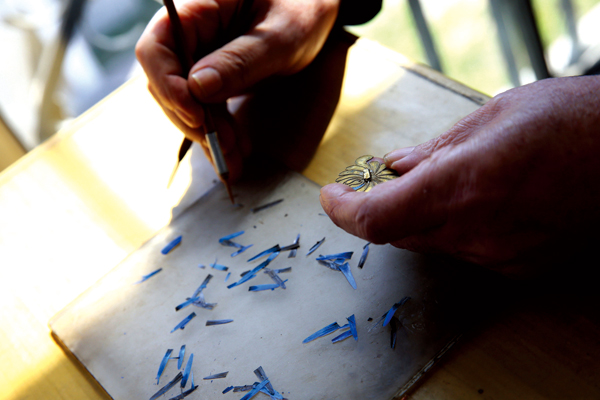 |
|
Dian cui master Xiao Guangchun works on a piece of jewelry. A piece of dian cui work needs a large amount of patience and time. Photos by Jiang Dong / China Daily |
Dian cui, the art of applying kingfisher feathers onto accessories, requires skill and a lot of patience. But like many age-old techniques, it risks being lost forever. Zhao Xu has the story.
Think gold is precious? If you listen to Xiao Guang-chun, the shimmering metal is almost nothing compared to another of Nature's treasures - this one commands a much more lustrous shine, a shine charged with an irrepressible, time-transcending life force.
It is the shine of kingfisher feather, the feather of a small, jewel-toned bird that Xiao has been applying tirelessly, for the past four decades, on the surfaces of antique golden accessories, in an effort to resuscitate their time-worn beauty and charm.
"Aesthetically, our ancestors placed the kingfisher feather way ahead of gold," says Xiao, pointing to the fact that the latter had been reduced to a mere "base" status in almost all head accessories made for upper-class court ladies during China's dynastic periods.
"Despite gold being valued as the most precious metal - and a form of currency - at that time, in creating jewelry, artisans routinely covered the entire surfaces of their gold-wrought designs with the feather, leaving only golden fringes to set off and accentuate the plume's iridescent blue hue.
"These days, the color is sometimes referred to as 'Turkish blue', after the Turkish turquoise I suppose. But in my view, it's a shade of its own, undefinable by any other worldly thing," says Xiao. "Mother Nature has only this one tube of paint and she lavishes it on the wings of this lucky little bird we call kingfisher."
But there's one thing that could, hopefully, do justice to the beauty of the feather. It's the name assigned to Xiao's art.
| Master strokes | Fresh-faced art |
|
|
|
|
|
|
|
|